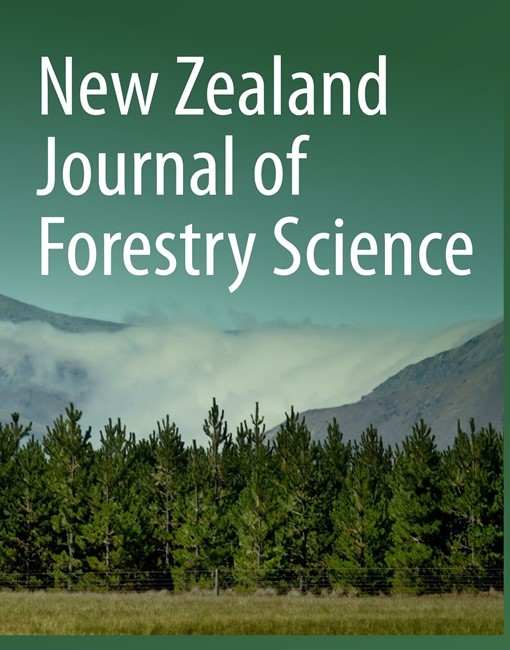View Item
- xmlui.general.dspace_homeCentros Regionales y EEAsCentro Regional Patagonia SurEEA Santa CruzArtículos científicosxmlui.ArtifactBrowser.ItemViewer.trail
- DSpace Home
- Centros Regionales y EEAs
- Centro Regional Patagonia Sur
- EEA Santa Cruz
- Artículos científicos
- View Item
Climate influence seed production in managed and unmanaged Nothofagus pumilio forests of Southern Patagonia
Abstract
Background: Annual seed production is key to understand natural forest dynamics and to apply sustainable forest management. This process is subjected to variations according to annual and seasonal climatic conditions, locally affected by El Niño-Southern Oscillation (ENSO) and the Southern Annular Mode (SAM) seasonality. Recognising how these variables affect the dynamics of harvested forests is useful for developing forest management strategies.
[ver mas...]
Background: Annual seed production is key to understand natural forest dynamics and to apply sustainable forest management. This process is subjected to variations according to annual and seasonal climatic conditions, locally affected by El Niño-Southern Oscillation (ENSO) and the Southern Annular Mode (SAM) seasonality. Recognising how these variables affect the dynamics of harvested forests is useful for developing forest management strategies. Therefore, the objective of this study was to analyse annual seed production (SP) in Nothofagus pumilio (Poepp. & Endl.) Krasser stands harvested under variable retention and unmanaged primary forests in Tierra del Fuego, Argentina, related to the occurrence of climatic events over a 17-year period (2006-2022).
Methods: Seed production (million ha-1 year-1) was annually measured in three managed stands with different retention levels (AR: aggregates; DRI: dispersed with aggregate protection; DR: dispersed without aggregate protection) and three primary forests (PF) stands as control sites (4 treatments x 3 areas x 6 replicates x 17 years). Values of occurrences of climatic events (positive or negative values of ENSO and SAM) were related to monthly temperature and rainfall. ANOVAs, correlation analyses and statistical modelling were performed to predict SP based on climatic variables and forest treatments. Results: Seed production varied over years and among forest treatments depending on annual climate variations, with annual averages for the studied period of: 9.35 million ha-1 year-1 for PF, 7.16 million ha-1 year-1 for AR, 2.25 million ha-1 year-1 for DRI and 1.08 million ha-1 year-1 for DR. ENSO+ and SAM+ acted as a trigger of high SP, associated to higher temperatures and dry conditions, mainly during spring and summer. The models predicted SP explaining 73-85% of its variability, considering minimum and maximum temperatures and ENSO mean values as better predictors. Conclusions: Findings presented in this study have important implications for forest management as a tool for
understanding forest dynamics related to seeding, a key factor for forest regeneration in a context of high climate variability. However, within a context of climate change with extreme events, there is a need for long-term monitoring of seeding processes in Nothofagus forests.
[Cerrar]

Author
Rodríguez‑Souilla, Julián;
Cellini, Juan Manuel;
Roig Junent, Fidel Alejandro;
Lencinas, María Vanessa;
Chaves, Jimena Elizabeth;
Aravena Acuña, Marie Claire;
Peri, Pablo Luis;
Martínez Pastur, Guillermo José;
Fuente
New Zealand Journal of Forestry Science 54 : e13. (2024)
Date
2024-07-24
Editorial
SCION
ISSN
1179-5395
Formato
pdf
Tipo de documento
artículo
Palabras Claves
Derechos de acceso
Abierto
 Excepto donde se diga explicitamente, este item se publica bajo la siguiente descripción: Creative Commons Attribution-NonCommercial-ShareAlike 2.5 Unported (CC BY-NC-SA 2.5)
Excepto donde se diga explicitamente, este item se publica bajo la siguiente descripción: Creative Commons Attribution-NonCommercial-ShareAlike 2.5 Unported (CC BY-NC-SA 2.5)
Metadata
Show full item recordRelated items
Showing items related by title, author, creator and subject.
-
La investigación en bosques nativos acompañando al desarrollo sustentable
Peri, Pablo Luis (Colegio de Graduados en Ciencias Forestales de Santiago de Estero, 2020)Los bosques nativos en Argentina, con su gran variedad de ecosistemas que incluyen desde selvas subtropicales hasta bosques subantárticos, brindan a la sociedad diferentes servicios ecosistémicos (alimentos, agua, madera, ... -
Propuesta de protocolos y lineamientos para evaluar planes de manejo de uso sustentable de los bosques
Rusch, Veronica Elena (Ediciones INTA, 2017)Par el empleo del protocolo, se propone pensar la evaluación como si fuera en una tabla donde se incluya cada una de las preguntas a considerar en la primera columna. La evaluación me permitirá responder si el aspecto de ... -
Restauración de bosques nativos : la importancia del origen de la semilla
Mondino, Victor Alejandro; Pastorino, Mario Juan (2016)Cuando se habla de degradación en los bosques se hace referencia a la pérdida de productividad y biodiversidad ocasionada por distintos tipos de disturbios como los incendios, tala indiscriminada, el sobrepastoreo y las ...


